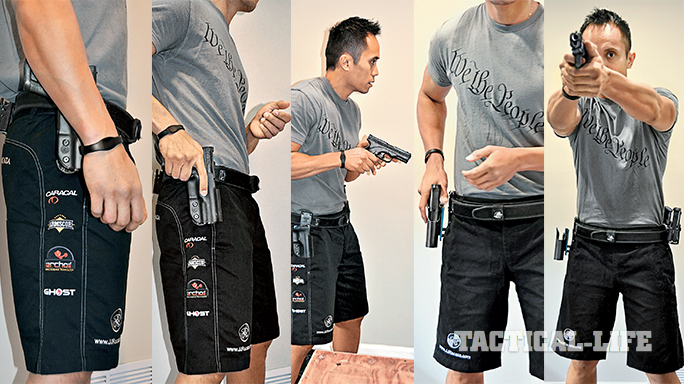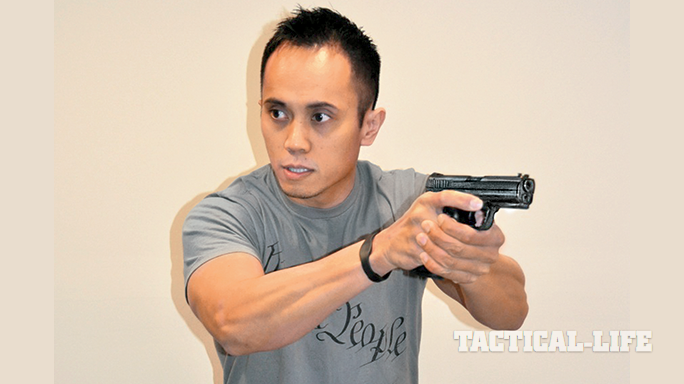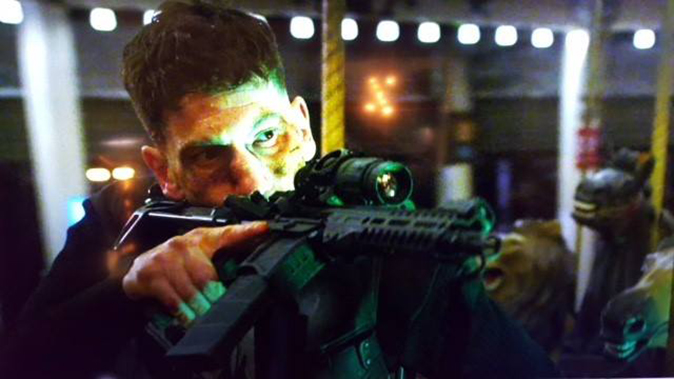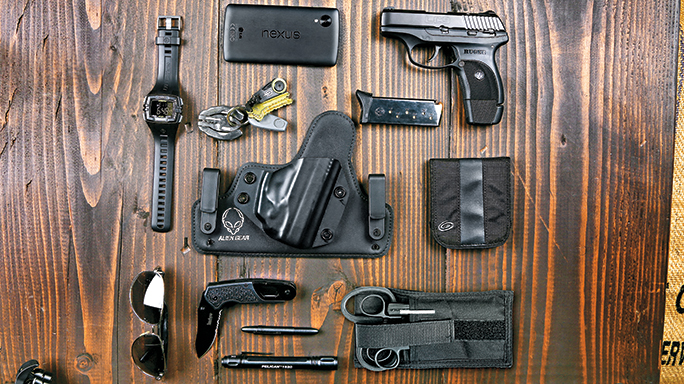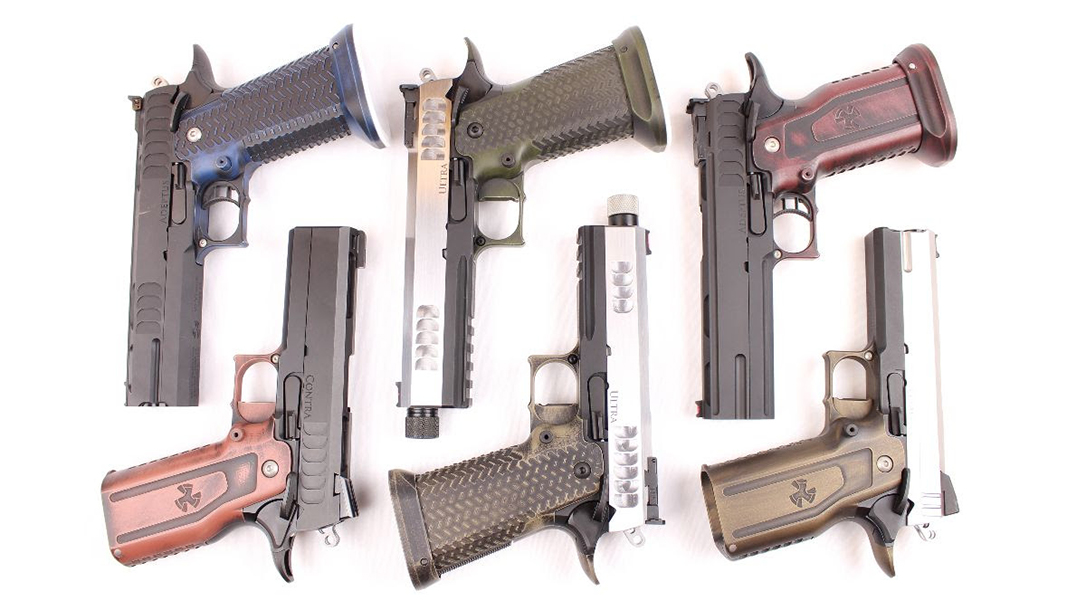Story written by JJ Racaza:
First, we have to understand that while dry firing is one of the best forms of practice to improve weapons handling, it can also become a detriment to your shooting.
Dry firing is most effective when the focus is on weapons handling and weapons familiarization. But sometimes, in the search for speed with draws, reloads and target/sight acquisition, we neglect the other very minute but very important part of shooting: trigger control.
- RELATED STORY: Dynamic Dry-Fire Training with Dave Harrington
I once fell into the trap of trying to beat the timer when the focus was on speed, as opposed to the speed of the movement. It should be noted that pushing yourself to this blinding speed is the result of constant repetition and the development of muscle memory. However, you should only begin to push the speed once you have developed your confidence and improved the consistency of your movement.
Own Your Moves
The application does not matter as long as it is efficient and you own it. There are many different techniques for drawing a gun. You’ll see some people meet and wrap near their holster, while some gravitate closer to the centerline of the body. Neither is better or worse. It all depends on a multitude of things: body composition, comfort level, purpose, style, personal preference, etc. In terms of progression, we all start learning a new movement by doing it slow and methodically. Then, through repetition, we progress from the robotic movement and become smooth and more natural. Once we have achieved smooth movements, we can start to add speed to the routine. This is where the saying, “slow is smooth and smooth is fast” comes from.
Lessons Learned
Between the years of 1987-1990, I was consistently dry firing for 45 to 60 minutes every day. These were the early years, when my father gave me a goal to get as confident and as fast as I could with the basic movements (draws, reloads, target transition, etc.).
“Dry firing with a sole focus on speed shows through inaccuracy.”
In the pursuit of mastering these basic movements through dry firing, I would challenge myself. For instance, while trying to speed up my draw and my first shot on target, I wanted to see tangible improvements, so I set up a timer at two seconds and progressed by taking time away. Within a few months, I was able to work my time from the buzzer to the break of the first shot down to one second; I even got down to the 0.7 seconds, breaking the 1.5-pound trigger with a decent sight picture on a 6-inch circle at 24 feet. The idea was to keep pushing until I determined what my limit was at the time; after that, I took it back a little and dry fired at my “comfort zone.” Comfort zone is a conscious working level where you believe you can perform consistently and comfortably at practice or during a match. So once I’ve pushed that limit for that time period, I take it back about 10 percent and settle there to perform over 100 repetitions of the same movement at my comfort zone pace.
- RELATED STORY: 11 Critical Shooting Drills to Improve Accuracy
This heavy focus on overall speed during these dry-fire sessions worked well in the beginning stages of my shooting career, when small mistakes were forgiven in the more elementary classification levels. I made steady gains with my weapons handling by constantly pushing the threshold in practice and working at my comfort zone during matches. My proficient weapons handling ability allowed me to be quicker and mask the mistakes I was making with my actual shooting.
Once I got into the higher classification level, however, I started to notice that speed alone no longer sufficed. At a certain point, speed started to become my detriment. The muscle memory I had built was now causing me some control issues at matches. At this level of shooting, competitors seem to have mastered weapon handling and speed, however the real key is not just to have mastered the weapons handling, but also to shoot fast accurately. This is where dry firing can become a detriment.
Identifying The Problem
After realizing the deficiencies in my accuracy, I continued to dry fire every day, and at times even increased the intensity of it. I tried out new techniques, such as observing myself in the mirror to try to identify inefficiencies of movement.
“After realizing the deficiencies in my accuracy, I continued to dry fire every day, and at times even increased the intensity of it.”
It was not until my father and I were working on accuracy drills from near to far distances (10 to 50 yards) that I finally figured out my problem. We were shooting in all three positions: standing, kneeling and prone. I had dry fired every position countless times, so I knew where my time should be if I pushed it and where it should be if I took my time and fell into my comfort zone. I seemed to be accurate from the 15-yard line and under (aren’t we all), but when we moved farther back, to 25 yards and beyond, my shot placement became much more erratic. And the harder I tried to take it slow, aim and be patient, the worse I became as a shooter. So, after several frustrating live-fire sessions of not being able to figure out how I could get more consistent at a distance, my father took out the notebook and pointed out that if I only learned to slow down my first shot to get a decent hit on target, then my successive shots might be more consistent on target. By reviewing the notes, there was a trend that we noticed about my first shot: At any distance, my first shot broke at the same time. This time mirrored exactly what I had been doing in my dry-fire sessions.
Training Solutions
Basically, I had developed a natural time clock in my head that prompted me to fire the gun at or around one second. I initially resorted to consciously slowing down to make a perfect shot. This altered my cadence and only lead to anticipated rounds, which resulted in erratic rounds on target. Slowing down is not the answer, learning the specific movements and focusing on how to correctly execute them is the key. Financially, the option of going to the range more for live fire did not make sense. We could not afford it. My only viable option was to figure out something during my dry-fire sessions and break this uncontrollable urge to break the shot around one second, no matter the distance.
So here are the changes I made to my dry fire. The routine, intensity, targets, and timer set up was all the same. The only thing I changed were the standards of how to measure my speed development. Before, in order to make the allotted time, I would have seen a sight picture, pulled the trigger and dropped the hammer before the second buzzer. This time around, I focused more on a steady sight picture before the second buzzer than pulling the trigger smoothly. Essentially, I was still pushing myself to go as fast as I could with everything except the trigger; I varied the timing of the trigger pull. Now the race was focused on seeing a steady sight picture and a steady gun as opposed to a rushed trigger.
- RELATED STORY: 6 Tips For Improved Trigger Pull with Rob Leatham
Dry firing with a sole focus on speed shows through inaccuracy. Granted, it’s good to see what the sights do when the trigger is manipulated that fast, but to do it every time you draw and present your gun at the target creates bad habits, and I would recommend otherwise.
DRY-FIRE DRILLS AT A GLANCE
Draw
- Static draw
- Dynamic (moving to a different position)
Transition (develops sight acquisition)
- Focus on variably spaced targets and drive the weapon as fast and as hard as you can into the next target. Work on getting a steady sight picture as soon as you get on target.
- There’s a fine balance between “speed” and “smooth” on this drill.
- Two techniques, depending on the distance between targets: Target first, Stay on sights.
Reloads: Static to Dynamic
- Focus on speeding up the grab and snatch of the next magazine.
- Drive the magazine as fast as you can close to the mag well.
- Depending on if you have an after-market mag well or not, you may have to perfect the timing of when to slow down enough before jamming the magazine into the gun.
- You can start with a single target and move on to multiple targets, acquiring the sights to a different target after each reload drill.
- Dynamic: Moving into a different shooting position (standing to kneeling, or standing to prone).
One Hand
- Draw with strong hand.
- Practicing the transfer from strong hand to support hand.
- Include multiple target transitional drills to include extreme, dynamic transitions.
Requirements for dry-fire practicing
- You’ll need makeshift targets or simulated distance targets, snap caps, shooting rig (inner and outer belt holster, pouches, etc.).
This article is from the August 2015 issue of COMBAT HANDGUNS. To subscribe or to read more from this issue, please visit PersonalDefenseWorld.com.








